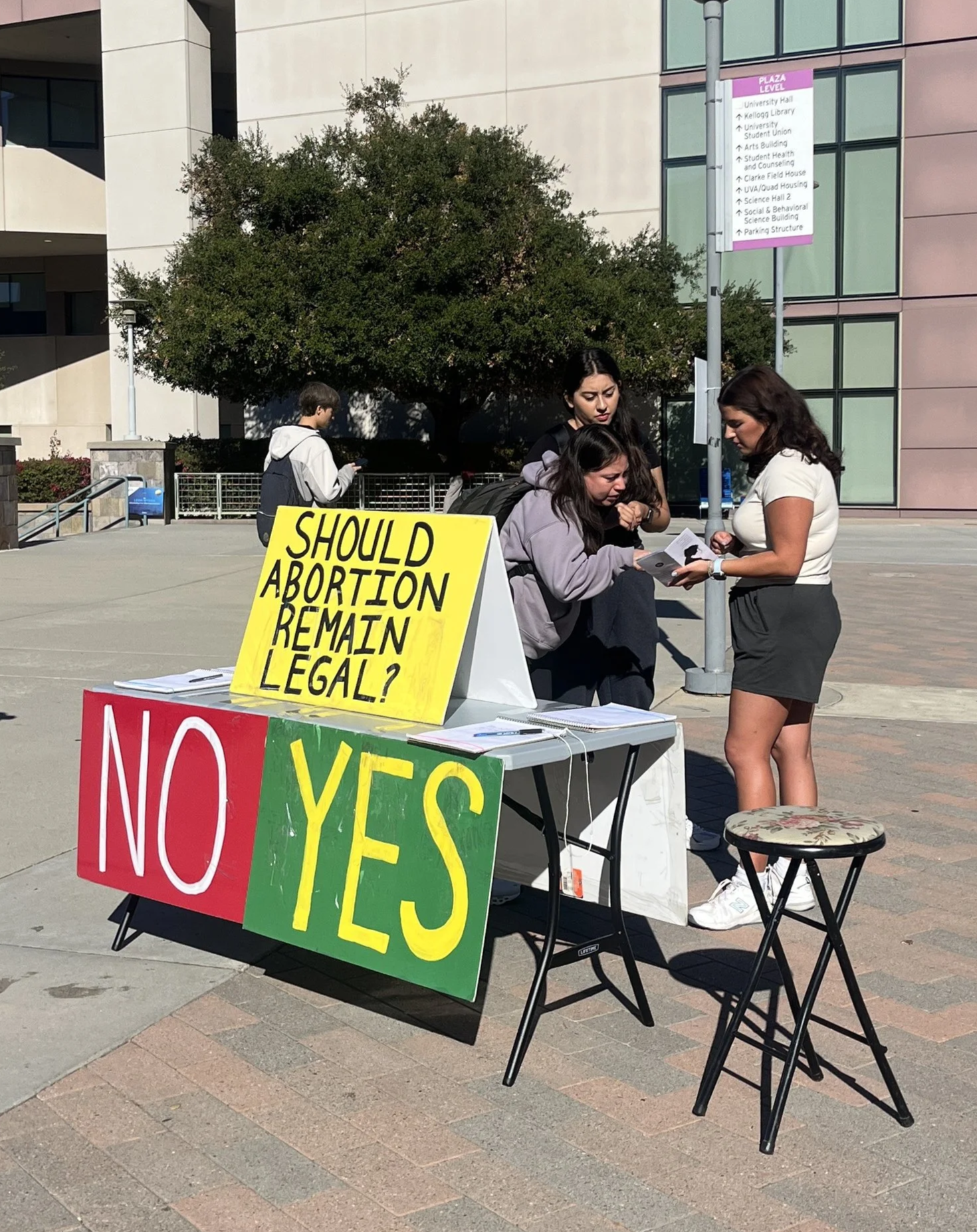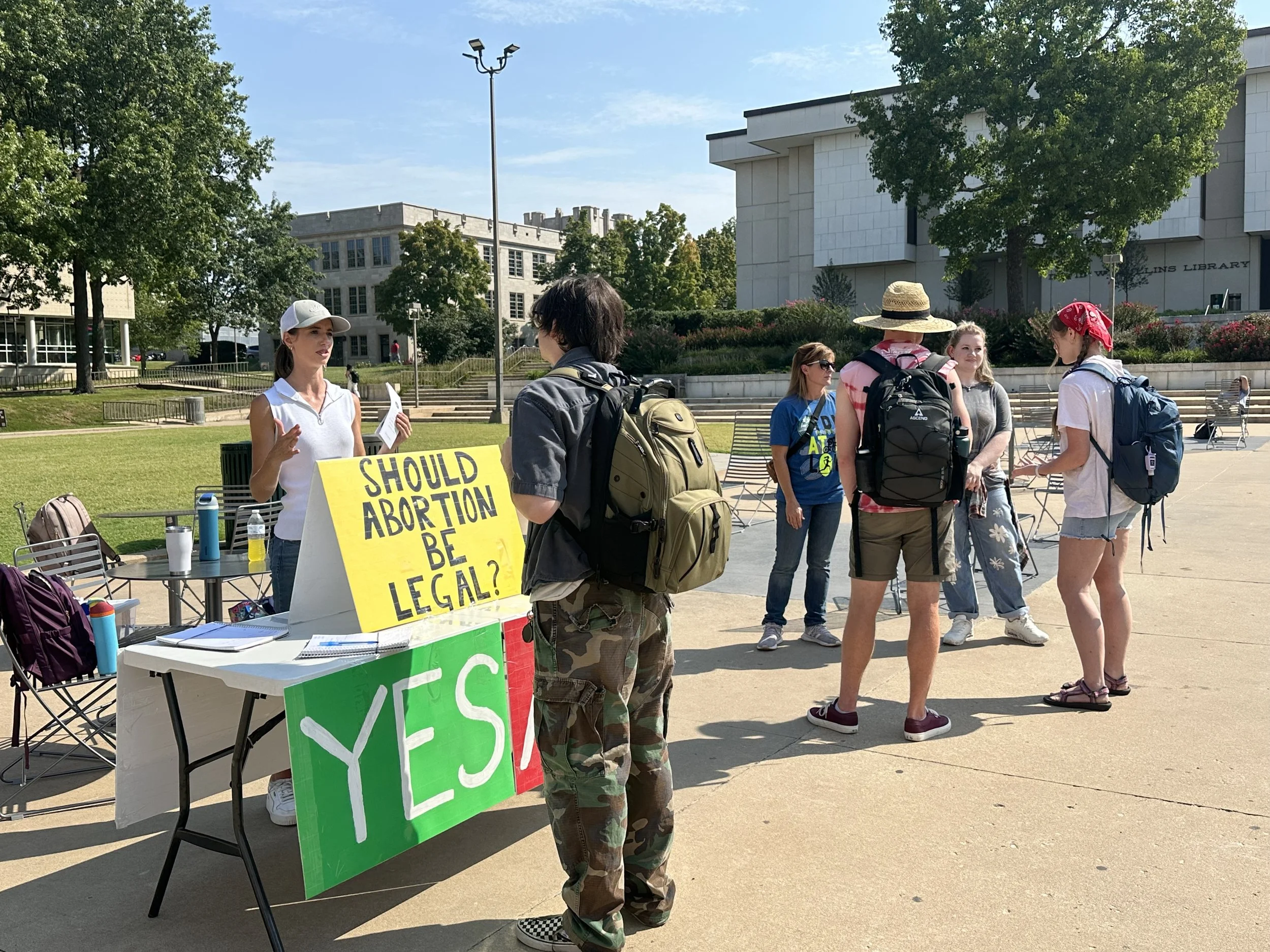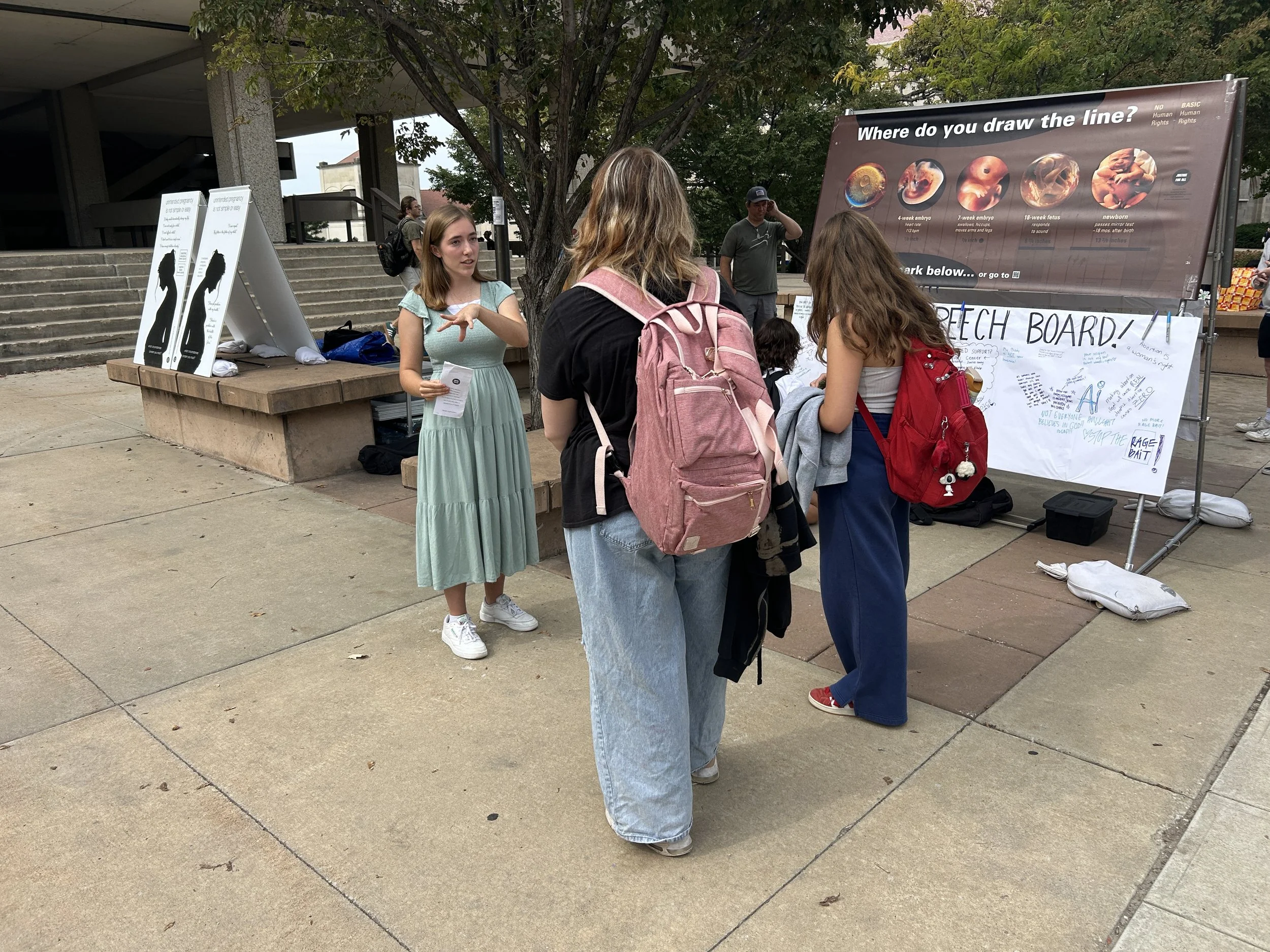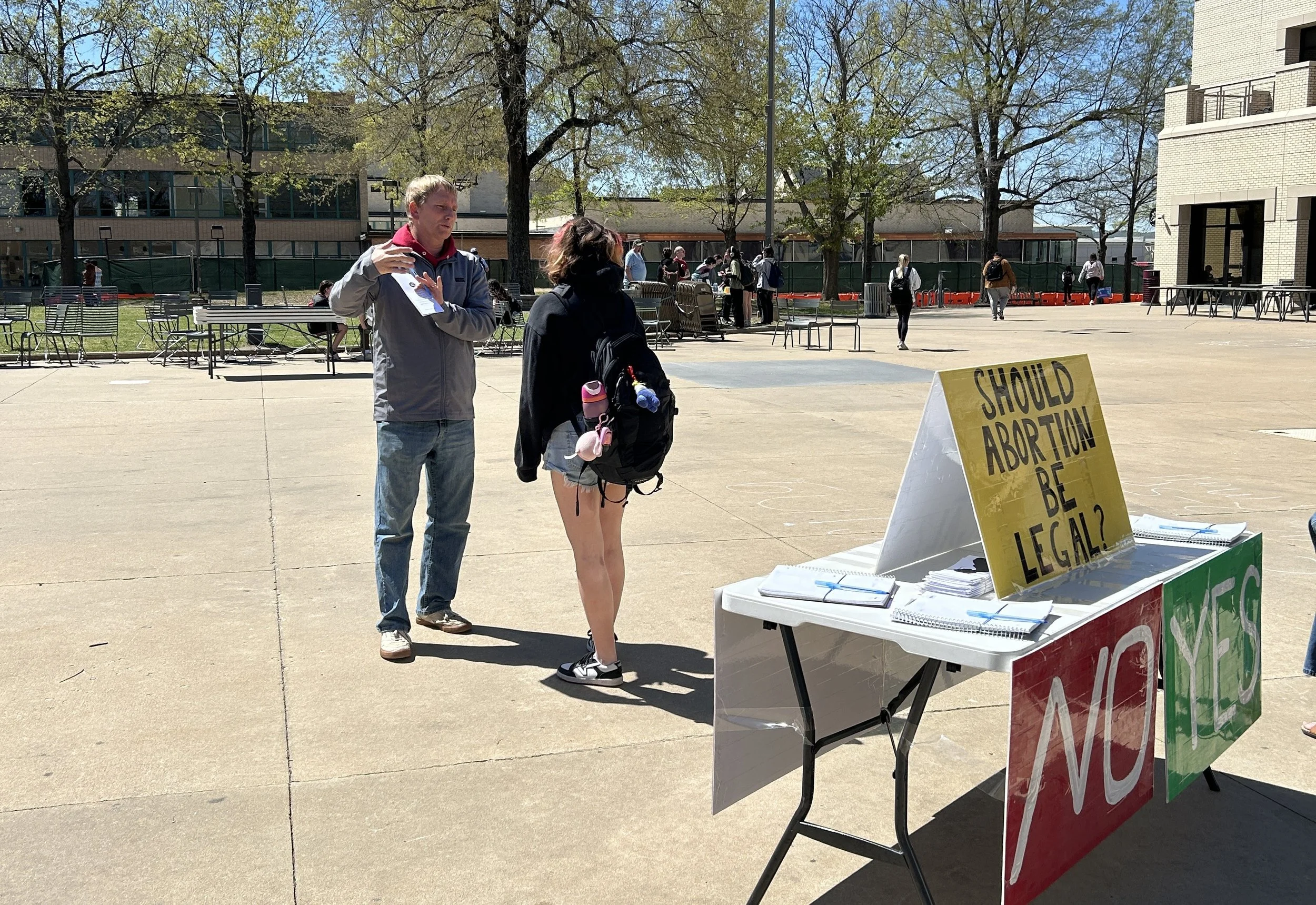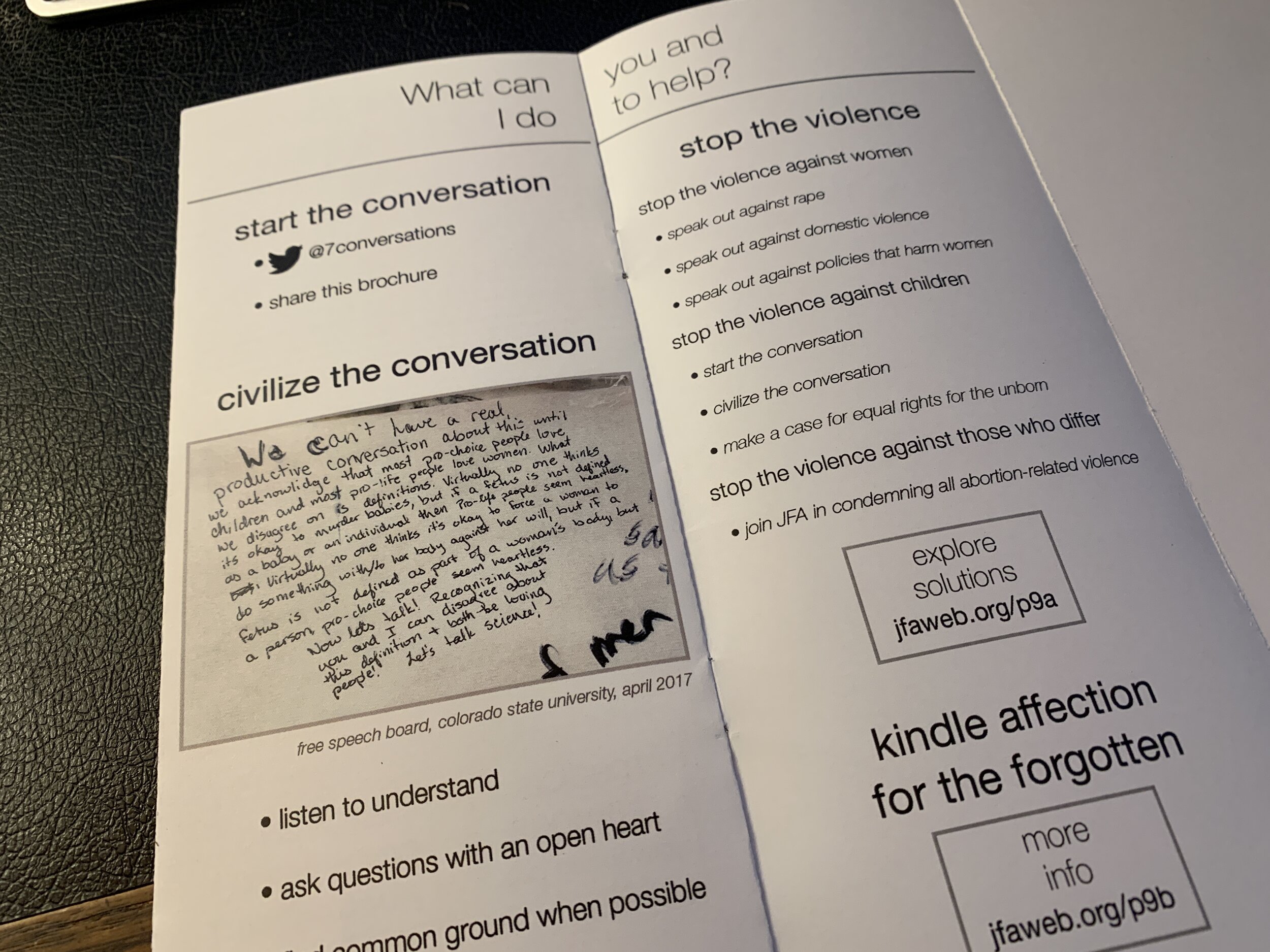Notes for "7 Conversations in 7 Hours - Session 7"
Comment Or Ask Questions on Session 7
Respond to Session 7 and Sign Up for JFA Updates via Email and/or Paper Mail using the JFA Updates page. Or, feel free to share a comment on this post below.
Next Step: Conversation Starter for Session 7
Note: Some of the conversation starters from Session 1 and Session 2 and Session 3 and Session 4 and Session 5 may still be helpful to you for starting conversations.
Continue Your Conversation from Session 1 (and Following Sessions)
If you used the conversation starter from Session 1, go back to the person you talked to and ask if he or she wants to continue the conversation.
Other Conversation Starters
Contact the webinar admin to request more conversation starters.
In-Depth Resources for Questions Covered in Session 7 (“Extended Q&A”)
Life of the Mother: What if the mother's life is in danger? Is abortion ok in that case?
Personally Opposed but Should Be Legal: My friend at church says she's personally opposed to abortion but she thinks abortion should be legal. How can I help her?
Back-Alley Abortion: If abortion is made illegal, won't more women die in the back alleys from unsafe abortions?
July 9, 2020 Session Updates: Here are some links Steve mentioned during the session:
Nov. 5, 2020 Session Update: Here’s the link to the story Steve shared at the end of the session:
Links to Important JFA Resources
JFA’s “Invitation to Dialogue” Brochure (Download the Virtual Brochure or Request a Paper Version.
Steve Wagner, Common Ground Without Compromise (free eBook offer)
JFA’s “What Are the Facts?” page (Question 7 of this resource includes facts about how common it is for women to cite rape as a contributing factor to their abortion.)
Note: This post was originally written on 7/7/2020 for our first “7 Conversations in 7 Hours” series. It was updated on 7/29/2020.
Links: See the JFA Calendar to view a series currently in progress or coming up soon. // Register here. // Share the details or invite a friend.
Notes for "7 Conversations in 7 Hours - Session 6"
Comment Or Ask Questions on Session 6
Respond to Session 6 and Sign Up for JFA Updates via Email and/or Paper Mail using the JFA Updates page. Or, feel free to share a comment on this post below.
A Suggested Beginning for Your Response
“I agree that women’s bodily rights are important and that they are still being trampled on throughout the world. Domestic violence, rape, slavery. All of these practices are horrific and evil, and I stand with you against these harms against women.
So, for abortion to be made illegal, I agree that it would be a big deal, because we would be telling women there is something they can’t do with their body. We’d be restricting them. I can understand how this topic seems heavy and how the person who wants to restrict abortion seems unconcerned about how this is affecting a woman’s right to her body.
For it to make sense to make abortion illegal, abortion would have to be much more than removing a mass of tissue. If that’s all it was, a simple surgery to remove a mass, I agree women should be able to get that by law.
Let’s say, though, that the case I’ve made that the unborn is a human being with equal rights to the rest of us. Then the woman’s bodily rights matter, but there is another human being with bodily rights, too. So, then a law against abortion may still be unjustified, but it at least is within the range of being possibly a reasonable policy. Can we agree on that?” - Steve Wagner
Next Step: Conversation Starter for Session 6
Note: Some of the conversation starters from Session 1 and Session 2 and Session 3 and Session 4 and Session 5 may still be helpful to you for starting conversations.
Option 1: Continue Your Conversation from Session 1 (and Following Sessions)
If you used the conversation starter from Session 1, go back to the person you talked to and ask if he or she wants to continue the conversation. Ask if he or she agrees that generally speaking, a woman has a right to do what she wants with her body, and point out that this right has been trampled throughout history (and continues to be in the present day). Then ask if abortion is an important component of that right. Throughout the conversation, focus on the empathy we developed in Sessions 5 and 6 (meeting the “Relational Challenge”) as you dialogue with your friend.
Option 2: Share the It’s Her Body Article
Ask a friend to read the first installment of Steve Wagner’s “It’s Her Body” series. Use what you learned in Session 6 to create a productive conversation with your friend.
Option 3: Share Pages 8-9 from the JFA Brochure
We shared this conversation idea in Session 5, but it also can help you start with common ground in conversations about a woman’s right to her body. Use pages 8-9 as a springboard for conversation about what each of us can do to stop the violence against women.
Option 4: Share the ERI Video
Share the video below to start a conversation. We suggest prefacing the video with a warning about its graphic descriptions of abortion as well as a discussion of the content of the “It’s Her Body” series linked above.
Links and Additional Reading for Session 6 (“Do Bodily Rights Mean Abortion Is Okay?”)
A Response to the Strongest Violinist (including more resources)
See also Timothy Brahm's "Autumn in the Sovereign Zone" for a masterful response to another version of bodily rights argument. Mr. Brahm now works at Equal Rights Institute.
See also "Good Samaritan on Life Support" by 2010 JFA Intern Tony George.
The main url for discussion of the paper, www.jfaweb.org/DFG, is now being directed to this post.
NEW: See our “12 Minutes on Bodily Rights” post featuring ERI’s video with Timothy Brahm’s updated thoughts on how to respond to bodily rights arguments (“Blood Donation and Bodily Rights Arguments” ).
ERI’s response to “Abortion as Self-Defense” is also helpful.
Other Bodily Rights resources (including link to debate between Trent Horn and David Boonin)
A Good Conversation Is…A Window - Steve Wagner (Nov./Dec. 2013)
JFA’s “Invitation to Dialogue” Brochure (Download the Virtual Brochure or Request a Paper Version.
Steve Wagner, Common Ground Without Compromise (free eBook offer)
JFA’s “What Are the Facts?” page (Question 7 of this resource includes facts about how common it is for women to cite rape as a contributing factor to their abortion.)
Note: This post was originally written on 7/1/2020 for our first “7 Conversations in 7 Hours” series. It was updated on 7/29/2020. The “Suggested Beginning to Your Response” section was added on 8/26/2020.
Links: See the JFA Calendar to view a series currently in progress or coming up soon. // Register here. // Share the details or invite a friend.
Notes for "7 Conversations in 7 Hours - Session 5"
Comment Or Ask Questions on Session 5
Respond to Session 5 and Sign Up for JFA Updates via Email and/or Paper Mail using the JFA Updates page. Or, feel free to share a comment on this post below.
Next Step: Conversation Starter for Session 5
Note: Some of the conversation starters from Session 1 and Session 2 and Session 3 and Session 4 may still be helpful to you for starting conversations.
Option 1: Continue Your Conversation from Session 1 (and Following Sessions)
If you used the conversation starter from Session 1, go back to the person you talked to and ask if he or she wants to continue the conversation. Mention that one of the most common topics that comes up in relation to the topics of unintended pregnancy and abortion is the topic of rape. Ask what your friend thinks about abortion in this case late in pregnancy…and early in pregnancy. Use what you learned in Session 5 to dialogue with your friend.
Option 2: Share Pages 2-3 from the JFA Brochure
Use the digital brochure or send this image. Ask, “which circumstances concern you most.” Usually, rape is one of the most common circumstances people raise. Use what you learned in Session 5 to create a productive conversation with your friend.
Option 3: Share Pages 8-9 from the JFA Brochure
Use pages 8-9 as a springboard for conversation about what each of us can do to stop the violence against women.
Links and Additional Reading for Session 5 (“The Question of Rape”)
JFA’s “Invitation to Dialogue” Brochure (Download the Virtual Brochure or Request a Paper Version.
Steve Wagner, Common Ground Without Compromise (free eBook offer)
JFA’s “What Are the Facts?” page (Question 7 of this resource includes facts about how common it is for women to cite rape as a contributing factor to their abortion.)
Note: This post was originally written on 6/19/2020 for our first “7 Conversations in 7 Hours” series. It was updated on 7/29/2020.
Links: See the JFA Calendar to view a series currently in progress or coming up soon. // Register here. // Share the details or invite a friend.
Notes for "7 Conversations in 7 Hours - Session 4"
Comment Or Ask Questions on Session 4
Respond to Session 1 and Sign Up for JFA Updates via Email and/or Paper Mail using the JFA Updates page. Or, feel free to share a comment on this post below.
Next Step: Conversation Starter for Session 4
Note: Some of the conversation starters from Session 1 and Session 2 and Session 3 may still be helpful to you for starting conversations.
Option 1: Continue Your Conversation from Session 1 (and Following Sessions)
If you used the conversation starter from Session 1, go back to the person you talked to and ask if he or she wants to continue the conversation. Share the Equal Rights Mystery and ask how the person would explain what is the same about all of us who deserve to be treated equally. If humanness is the answer given, then ask what this would mean for the unborn. If another answer is given, clarify which animals and humans would be in and which would be out of the equal rights community (like the blue box activity). Ask, “Does this implication of your view make sense?”
Option 2: Share the Video of CK’s Conversation
Share the video below and ask your friend what he or she thinks of the conversation.
Option 3: Share the Video of Becca Hotovy’s Conversation
Share the video below and ask your friend what he or she thinks of the conversation.
Option 4: Share these Social Media Posts
Option 5: Share Question 22 from Common Ground Without Compromise
Question 22 asks, “Are you opposed to sexism and racism?” You can share the short discussion that follows to start a conversation. Download and share the book at its web page.
Links and Additional Reading for Session 4 (“The Equal Rights Mystery”)
Other Resources
JFA’s “Invitation to Dialogue” Brochure (Download the Virtual Brochure or Request a Paper Version.
Steve Wagner, Common Ground Without Compromise (free eBook offer)
Note: This post was originally written on 6/16/2020 for our first “7 Conversations in 7 Hours” series. It was updated on 7/29/2020.
Links: See the JFA Calendar to view a series currently in progress or coming up soon. // Register here. // Share the details or invite a friend.
Notes for "7 Conversations in 7 Hours - Session 3"
Comment Or Ask Questions on Session 3
Respond to Session 1 and Sign Up for JFA Updates via Email and/or Paper Mail using the JFA Updates page. Or, feel free to share a comment on this post below.
Next Step: Conversation Starter for Session 3
Note: Some of the conversation starters from Session 1 and Session 2 may still be helpful to you for starting conversations.
Option 1: Continue Your Conversation from Session 1
If you used the conversation starter from Session 1, go back to the person you talked to and ask if he or she wants to continue the conversation. Focus on finding common ground first regarding the circumstances the person brings up in order to justify abortion. Then trot out a toddler to try to bring clarity to the need to answer the question, “What is the unborn?” If the person seems open, share some of the biological evidence supporting the idea that the unborn is a living human organism. Make sure to listen to understand, ask these questions with an open heart, listen to understand what the person means with his or her responses, and find common ground when possible. Gently challenge mistakes in thinking using the ideas you learned this week.
Option 2: Use Video from EHD to Start a Conversation
Share the beautiful video images from EHD (JFA’s “What Is the Unborn?” page or the Links page) on social media or through email. You might say:
“In the midst of the ugly and violent images on social media and news this week, I learned about some beautiful video of unborn children in my class on unintended pregnancy and abortion that I thought might be uplifting to you.”
Option 3: Share these Social Media Posts
Links and Additional Reading for Session 3 (“One Central Question”)
Video Post: “She’s Not Sure What to Think…How About You?” (CK Wisner in Conversation)
Read More Arguments Defending the Unborn as a Living Human Organism
JFA’s “Invitation to Dialogue” Brochure (Download the Virtual Brochure or Request a Paper Version.
Steve Wagner, Common Ground Without Compromise (free eBook offer)
Note: This post was originally written on 6/9/2020 for our first “7 Conversations in 7 Hours” series. It was updated on 7/29/2020.
Links: See the JFA Calendar to view a series currently in progress or coming up soon. // Register here. // Share the details or invite a friend.
Notes for "7 Conversations in 7 Hours - Session 2"
Comment Or Ask Questions on Session 2
Respond to Session 1 and Sign Up for JFA Updates via Email and/or Paper Mail using the JFA Updates page. Or, feel free to share a comment on this post below.
Request a Free Paper Copy of the “Invitation to Dialogue” Brochure
Use the Digital Online Brochure
View Video Resources Covered in this Session
What is the unborn? (Includes links to EHD apps and EHD video; along with embryology quotes and links to scientific journal articles)
Next Step: Conversation Starter for Session 2
Option 1: Opt Out of a Conversation
As you observe the unrest and lawlessness in many cities taking place across the country over the last few months (following the deaths of George Floyd and others), and as you survey the news of this particular week in which you are taking Session 2, you may feel like starting a conversation about abortion, especially related to abortion imagery, seems awkward or out of place. You may be surprised that many people would not find it awkward to discuss abortion imagery and may even be more comfortable with it, given the images in the news. With this in mind, and considering how serious the injustice of abortion is against a whole class of people (unwanted unborn human beings), we would still encourage you to consider the conversation starters below and see if you can make use of them.
If after reflection on the above paragraph you feel like you would prefer to not try to use images in a conversation this week, we suggest spending the time you might have spent on conversations to pause to pray to God to bring an end injustice in all of its forms, to comfort the hurting, and to solve the very challenging problems we’re seeing all around us. If you are not a religious person, or as an additional activity, we suggest listening to and reflecting on the stories of oppressed peoples wherever they are in the US and around the world.
Option 2: Use the Three Essential Skills in a Conversation with Friends about this Cultural Moment
Many of our participants will find themselves in a conversation with a spouse, child, relative, friend, or neighbor about the unrest taking place in the US, or about topics like racism, the brutality of certain errant police officers, “conservatives,” “liberals,” whites, blacks, Latinos, Asians, the proper use of law, the proper use of force, how to keep law and order, whether various strategies for bringing about change are justified, and other topics. We suggest engaging in these conversations with a conscious emphasis on the three essential skills: Listening to understand, asking questions with an open heart, and finding common ground when possible. When I engage in these conversations, one way to form questions for the other person is to first ask oneself questions like the following:
What am I assuming about this person’s communication? Am I adding some meaning to the plain words being said?
Am I giving this person the benefit of the doubt or believing the worst?
Am I trying to hear what the person intended or am I reacting to a meaning she didn’t intend?
Are there words this person is saying that may have more than one meaning? Which words would it help to clarify?
Are there things about this topic I don’t know?
Is there anything this person is saying that I can agree with? Have I pointed that thing out?
Is the person intending to make an argument or express a feeling? If it’s a feeling, have I validated the feeling?
Is the person thinking the topic through in real time with me listening?
Does the person appear to be confident because she is actually confident or is the confidence a part of the person’s personality that doesn’t relate to what’s going on with the topic for her?
Are there things this person is certain about that I can agree with? Are there things this person is skeptical about or uncertain about that I can identify with? Have I found common ground on the feeling of uncertainty or fear that she is feeling?
I hear the statement this person is making. I don’t agree. I wonder what it would take for me to come to agree. What amount of evidence would be sufficient? What type of authority would help convince me?
Option 3: Use the JFA Brochure Tour to Start a Conversation
Use the prompt on Page 33 of the Interactive Guide and use the script to help you structure your conversation.
Option 4: Use Delightful Images of the Unborn to Encourage a Pro-Life Friend
Even with all of the unrest in the US right now, if you want to create a conversation about the unborn this week using what you learned in Session 2, we suggest sharing the beautiful images found on JFA’s What Is the Unborn page (or the Links page — also linked above) with a pro-life friend as an encouragement. You might say:
“In the midst of the ugly and violent images on social media and news this week, I learned about some beautiful video of unborn children in my class on pro-life dialogue that I thought would encourage you.”
Links and Additional Reading for Session 2 (“Do Images Help?”)
JFA’s “Invitation to Dialogue” Brochure (Download the Virtual Brochure or Request a Paper Version.
Steve Wagner, Common Ground Without Compromise (free eBook offer)
Stories Related to Using Pictures
Steve Wagner, “Bryndan Gets the Picture” (June 2012 Newsletter) (Warning: Graphic Picture Included)
Charity on the Metro - Impact Report - Jan. 2015 - Steve Wagner / Charity Boaz
Repeat Work in Science Class - "The Conversation" - Laura Beeson
Facing Abortion - Collection - Four Conversation Stories Illustrating the Importance of Pictures (Warning: Graphic Picture Included)
Note: This post was originally written on 6/2/2020 for our first “7 Conversations in 7 Hours” series. It was updated on 7/29/2020 and 10/1/2020.
Links: See the JFA Calendar to view a series currently in progress or coming up soon. // Register here. // Share the details or invite a friend.
Notes for "7 Conversations in 7 Hours - Session 1"
Comment Or Ask Questions on Session 1
Respond to Session 1 and Sign Up for JFA Updates via Email and/or Paper Mail using the JFA Updates page. Or, feel free to share a comment on this post below.
Next Step: Conversation Starter to Put Session 1 into Practice
Option 1: Talk to Someone You Know Well via Phone or Video Chat or in Person*:
Consider three people you know who are either pro-choice or whose views on abortion you don’t know. Choose the person on the list who you believe will be the most approachable or easiest for you to talk to about abortion. Your goal is to start the conversation with that person in a natural, non-awkward way. We suggest using a direct approach which is up front about how you are purposefully trying to learn something, and you need the person’s help:
“I’m troubled by the fact that good conversations about abortion are rare. It seems to only be hurtful to people. I’ve been working recently on learning to discuss abortion productively. Would you be willing to sit and chat with me for 15 minutes or more and help me out? My commitment to you would be that I will ask questions with an open heart, listen to understand, and find common ground when possible.”
Please adjust the wording to fit your personality! Once you’ve had a conversation with the person who’s most approachable for you, challenge yourself by engaging one of the others on your list.
Another alternative is to tell the person you’re doing an assignment for a class you’re taking:
“I’m taking a class aimed at helping people create better conversations about difficult topics. The topics we’re focusing on are unintended pregnancy and abortion. I’m wondering if you would be willing to have a 15-minute conversation with me to help me out. The assignment for this week is to ask someone what they think about these topics and to listen, ask clarification questions, and find common ground without challenging anything that’s shared for the whole 15-minute conversation. Would you be willing to help me out?”
*During COVID-19, we suggest being very careful to respect personal boundaries and social distancing expectations. We are thinking here of conversations with neighbors over the backyard fence in which you can respect social distancing expectations but also be close enough that you don’t have to yell to be heard:)
Option 2: Talk to Someone You Care About with Whom Past Abortion Conversations Have Gone Badly
Introduce the conversation by saying,
“I wanted to contact you and say something about how I’ve treated you in past conversations about abortion. In short, I am sorry for the way I’ve treated you. I think I communicated that I don’t care about you or your opinions through the way I responded to you in those conversations. Would you forgive me? [Wait for a response.] I am wondering if you would allow me to try again. I just took a class in three skills I am trying to learn to put into practice: listening to understand, asking questions with an open heart, and finding common ground when possible. Would you be willing to talk to me for 15 minutes about abortion? I promise to do my best to use these skills to show you the respect you deserve.”
Option 3: Talk to a Stranger
The difficult thing about this suggestion during COVID-19 is that many of the usual places we might have suggested to find people to talk to (college campuses, parks, etc) are closed, and indeed, in downtown walking areas and other locations that may still be open, many people are very skittish about getting in conversations with strangers for fear of contracting COVID-19. We’ve included this idea here only to encourage you to think creatively about whether God has put people in your path with whom you could speak without making them feel uncomfortable.
For example, you may participate in a Facebook group devoted to some other topic or shared interest. You might direct message someone (if it doesn’t break community rules for that group) to ask them to take an informal survey you’re conducting. This appeal might be even more persuasive if you commit to ask 10 people to take the survey. Then you might even report back on the results of the survey to the people who took it!
If you take this approach, you might use the JFA “Invitation to Dialogue” Survey which draws questions from the JFA “Invitation to Dialogue” Brochure.
Or, you might combine this approach with Option 1 above and just suggest to the person via direct message that you’re starting conversations about abortion.
Option 4: Share Steve Wagner’s Book with a Friend
Steve Wagner published Common Ground Without Compromise: 25 Questions to Create Dialogue on Abortion in 2008 expressly for the purpose of helping people create conversations. It’s a letter to pro-life and pro-choice people written in language both groups will understand and appreciate. The goal is to start the conversation with some aspect of the discussion on which we are all likely to agree so that we can then proceed to discussing our disagreements more productively. Each chapter is short and many of the chapters model this process of moving from agreement to disagreement. This makes the book a good tool for starting a conversation. What’s more, the book is available for free at Steve’s book web page.
Tell Us How Your Conversation Went
Don’t forget to use the "Share Your JFA Story" form to let us know how it goes.
Read More About Session 1 (“Three Essential Skills”)
Common Ground Without Compromise by Steve Wagner (free eBook offer)
A New View of Abortion…and Pro-Life Advocates (Mary St. Hilaire)
During Q&A in the Tues. Night session, I (Steve) answered a question about a conversation I had with a young woman at CU Boulder. To read about that conversation, request the free eBook version of Common Ground Without Compromise. It’s the opening story. Although I asked questions in the conversation, it was clear to this young woman that I wasn’t very interested in her opinion. I was interested in changing her opinions that I knew were incorrect, however, and that led her to say, “If you’re not going to listen to me, I’m just going to leave.” So, asking questions is necessary, but it’s not sufficient. Listening to understand rather than to refute can help create an environment in which the person wants the conversation to continue and wants to think carefully about the different ideas being presented.
Update 6-18-2020: “A Different Kind of Conversation” by JFA Intern Rebekah Dyer (Human Defense Initiative)
Note: This post was originally written on 5/26/2020 for our first “7 Conversations in 7 Hours” series. It was updated on 6/18/2020 and 7/29/2020.
Links: See the JFA Calendar to view a series currently in progress or coming up soon. // Register here. // Share the details or invite a friend.

